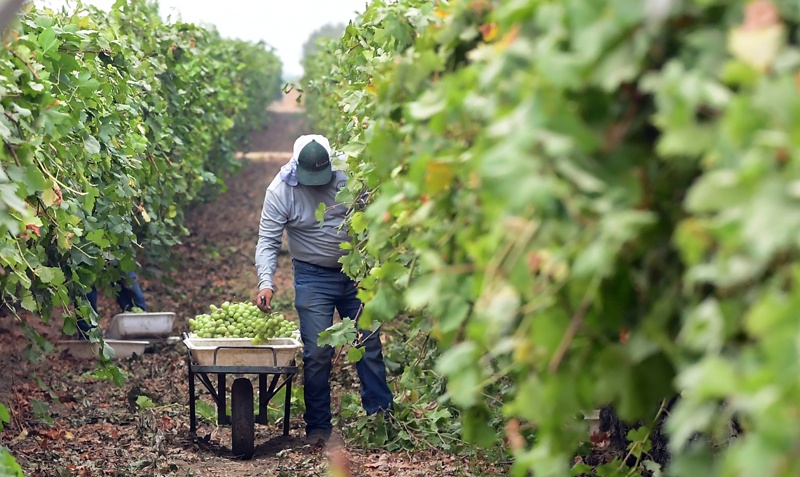 LAMONT, US: A farmworker picks grapes in the Kern County town of Lamont, California, where record heat has fuelled drought and wildfires. – AFP
LAMONT, US: A farmworker picks grapes in the Kern County town of Lamont, California, where record heat has fuelled drought and wildfires. – AFP
LAMONT, US: Irma Gomez has worked in California's Central Valley, one of the world's most productive agricultural regions, for nearly a decade-but she has never experienced a year as hot as this one, so hot that a colleague collapsed and died in the fields. "It's worrying," Gomez says. "It could happen to any of us." Rising temperatures are increasingly threatening workers in the United States, endangering their health as well as their performance.
And that has major economic consequences for the entire country, according to two recent studies.
The United States already loses an estimated $100 billion annually due to heat-related dips in productivity, says a report by the Adrienne Arsht-Rockefeller Foundation's Resilience Center, a Washington DC-based think tank. If no action is taken to curb global warming, losses will reach $200 billion by 2030 and $500 billion by 2050, the study says. "When you are slowed down and you need to have a break to have cold drinks and get in the shade, you produce less," says Kathy Baughman McLeod, director of the Resilience Center.
The first impact of such slowdowns is on workers' income. "In many fields like agriculture, workers are paid hourly or paid by the piece," says Kristina Dahl, co-author of a study conducted by the Union of Concerned Scientists, a non-governmental organization specializing in issues such as global warming. "So if the workers are getting that time out and not being compensated for it, then that has implications for their financial well-being as well."
Gomez, 37, said there has been less work this year because of the heat-and it has affected her basic needs, like her ability to pay for housing. Unable to work eight-hour days, she received $1,700 a month this summer, $700 less than the same period last year. For her, the difference is equivalent to a month's rent.
Everyone affected
As the heat continues to rise, breaks will only become more frequently necessary, warns the Union of Concerned Scientists. Three million workers in the United States experience at least one working week each year in temperatures above 37.7 degrees Celsius (100 degrees Fahrenheit), where heat puts them at risk. If current weather patterns continue, by the middle of the century, some 18.4 million people will be working more than a week in such extreme conditions-which means more breaks to protect health.
"Everyone, no matter what job they have, is going to feel the effects of that drop in productivity," says Dahl. After all, the people working in that heat are the ones who are outside "planting and harvesting our food, they are delivering our packages, they are maintaining our buildings, roads and bridges," she says.
Working in too much heat slows down movement. It causes fatigue, confusion, fainting and, in the most severe cases, a rise in body temperature that can be fatal.
It is estimated that in California alone, "hotter temperatures may be causing upwards of tens of thousands of workplace injuries each year," warns economist Jisung Park, a professor at the University of California, Los Angeles.
To protect herself from the sun, Gomez wears a long-sleeved T-shirt and trousers, as well as a cap and head scarf. On this autumn day, she has also donned a face mask because of the smoke from forest fires, which blanket the sky in a dense ochre haze.
Deadly heat
The two studies agree that the priority is to rapidly reduce greenhouse gas emissions to limit the rise in temperatures. But while waiting for this to be achieved, they advocate taking care of workers. "It really boils down to, give workers three things: water, shade and rest," says Dahl. "Most people don't know but heat is killing more Americans than any other climate hazards," says Baughman McLeod. Both experts see the need for a federal law that provides for paid breaks, in addition to protective measures.
"The objective is that the workers don't have to choose between their health and their paychecks," says Dahl. In September, the White House announced it would consider regulations to protect workers-but the process takes time. California, Minnesota and Washington are the only states in the country with regulations. On very hot days, companies are required to provide water and shade for workers. And in extreme temperatures, they must stop work altogether. In rural areas, one alternative to this is for workers to harvest at night or in the early hours of the morning.
But this creates other challenges. Gomez, for example, loses days when she cannot find a babysitter for her youngest daughter in the early hours of the morning. Now she is relieved that the summer temperatures are behind her, but she fears for the future. "We don't know what next year will be like," she says. - AFP




